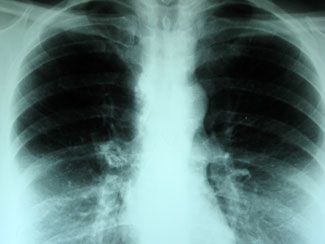Eribulin Fails to Meet OS Endpoint in NSCLC
A preliminary analysis has shown that eribulin mesylate (Haloven) failed to meet its primary endpoint of improving overall survival in pre-treated patients with advanced NSCLC.
A preliminary analysis has shown that eribulin mesylate (Haloven) failed to meet its primary endpoint of improving overall survival in pre-treated patients with advanced NSCLC.

A preliminary analysis has shown that eribulin mesylate (Haloven) failed to meet its primary endpoint of improving overall survival (OS) in pre-treated patients with advanced non-small cell lung cancer (NSCLC), Eisai, the developer of the agent, announced.
Study 302, a global, multicenter, randomized, open-label phase III trial, was conducted to compare the efficacy and safety of eribulin with a single treatment of physician's choice (TPC) consisting of either docetaxel, pemetrexed, gemcitabine, or vinorelbine.
“We know that NSCLC is a difficult-to-treat tumor type with no chemotherapy recognized as a standard treatment following two prior regimens. This is a disease which still has significant unmet medical needs,” Kenichi Nomoto, PhD, president, Oncology Product Creation Unit, Eisai Product Creation Systems, said in a statement. “While eribulin did not show an improvement in OS compared to TPC in this study, the trial demonstrates that eribulin has anticancer activity in advanced NSCLC patients following at least two prior regimens and further analyses of the results are ongoing. These results do not affect the current approved indications for Halaven.”
In the study, 540 patients with advanced NSCLC and disease progression following at least two prior regimens for advanced disease, which included a platinum-based regimen, were enrolled. According to a preliminary analysis, the median OS in both arms was 9.5 months (HR =1.16;P= .1343).
The preliminary safety analysis showed that the most common adverse reactions in the eribulin arm were decreased appetite, neutropenia, alopecia, nausea, and fatigue, which were consistent with the known safety profile of eribulin.
Full results of the study will be presented at a future conference, Eisai announced.
A phase II study of eribulin in patients with advanced NSCLC who had progressed during or after platinum-based doublet chemotherapy found the agent is active and tolerated as second- or later-line chemotherapy for NSCLC.
In this study, two patient cohorts (taxane-pre-treated and taxane-naïve) received eribulin mesylate (1.4 mg/m2) as a 2- to 5-minute intravenous infusion on days 1, 8, and 15 of a 28-day cycle. In order to assess tolerability of a second dosing schedule, a cohort of taxane-pre-treated patients received eribulin on days 1 and 8 of a 21-day cycle.
According to study results, 103 patients received eribulin with an ORR of 9.7% (all partial responses [PR]). Median duration of response, progression-free survival, and overall survival were 5.8, 3.4, and 9.4 months, respectively.
The most common treatment-related adverse events seen on the study were neutropenia (54%), fatigue (49%), nausea (38%), alopecia (32%) anemia (29%), and neuropathy (23%).
The 28-day schedule was associated with many dose delays, interruptions, or omissions due to neutropenia (day 15) while the 21-day cycle was well tolerated.
Eribulin is first in the halichondrin class of microtubule dynamics inhibitors with a novel mechanism of action. It was first approved as treatment for metastatic breast cancer in the United States in November 2010.
Eribulin is also being studied as potential treatment in ovarian cancer, cancer of the urothelium, and osteosarcoma.